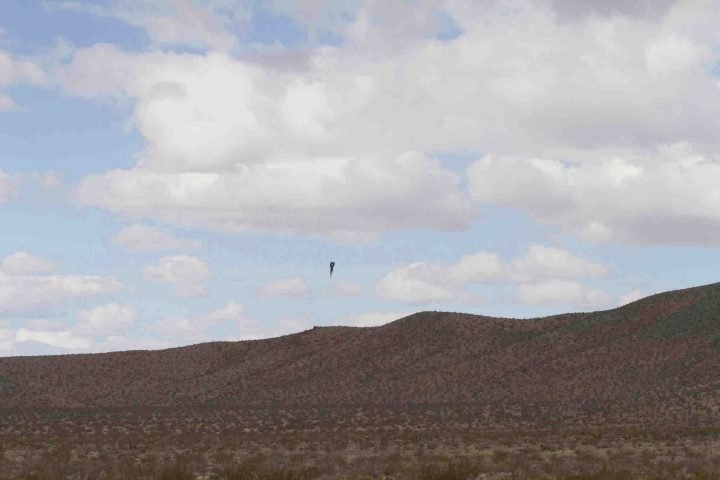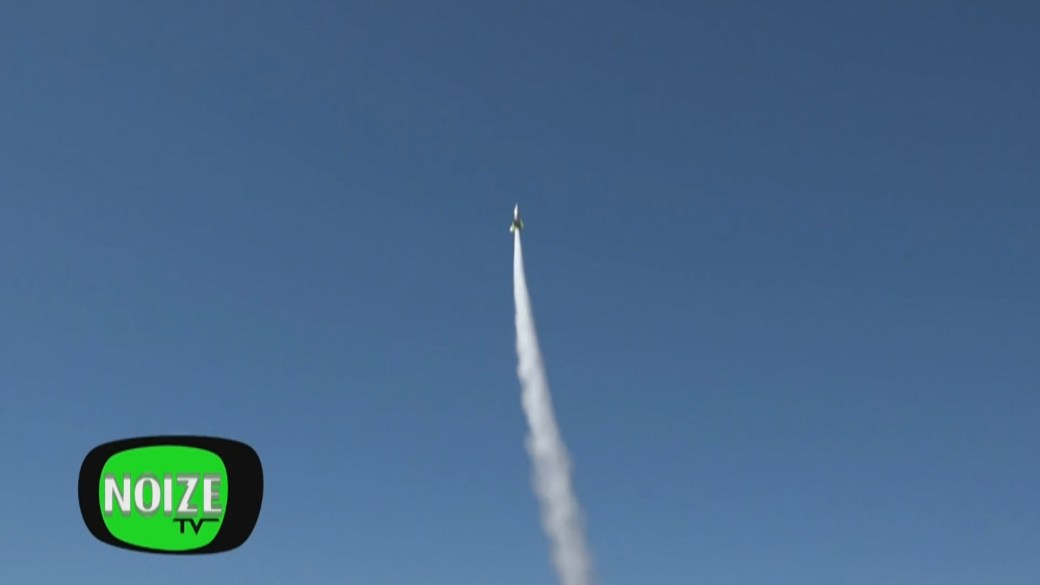Flat-Earth martyr or victim? ‘Mad’ Mike Hughes dies in DIY rocket crash
Self-styled daredevil “Mad” Mike Hughes has died after crashing his homemade rocket-balloon into the California desert while supposedly trying to prove that the Earth is flat.
It’s not.
Nevertheless, Hughes died chasing “proof” of a viral conspiracy theory he championed for years. The 64-year-old was the lone occupant of a steam-powered rocket that blasted off from the desert near Barstow, Calif., on Saturday afternoon, in a failed effort to fly high enough to photograph the “flat” planet.
Video recorded by freelance journalist Jason Chapman shows the rocket taking off with a hiss of steam, shedding a green parachute on its way up before disappearing into the clear blue sky.

A few seconds later the arrow-shaped rocket can be seen nose-diving back to Earth. It ultimately slams into the desert ground head-on, kicking up a cloud of dust in the process.

“Michael ‘Mad Mike’ Hughes tragically passed away today during an attempt to launch his homemade rocket,” the Discovery Channel said in a statement on Saturday. Discovery cameras were on-hand for the launch, which was slated to be part of an upcoming show called Homemade Astronauts. It’s unclear what will happen with that part of the show.
“A man was pronounced deceased after the rocket crashed in the open desert during a rocket launch event,” San Bernardino County Sheriff’s Department said in a statement.
Hughes was a longtime stunt driver turned amateur rocket-builder and so-called “Flat Earther” — a term for supporters of a viral conspiracy theory that combines a stone-age worldview with the feverish internet speculation of the 21st century.
The Flat Earth theory goes like this: the world is flat (or maybe a pear-shaped object), and the sun is a burning ball that revolves around it. It’s not really a sphere orbiting a star and scientists, airlines and world leaders are conspiring to keep it all secret.
“I don’t know if the world is flat or round,” Hughes said in a video posted on BBC News’ website back in 2018.
“I don’t want to take anyone else’s word for it.”
Hughes’ plan was always simple: He wanted to launch himself 100 kilometres (62 miles) above the Earth, past the so-called Karman Line separating the Earth’s atmosphere from space. Hughes would take footage all the way up, in hopes of reaching space and obtaining photographic proof that the Earth is flat.
“It’ll shut the door on this ball Earth,” he said at the time.
Hughes made international headlines with his first public launch on March 24, 2018, after crowdfunding for the mission through the Flat Earther community. His steam engine-balloon hybrid carried him about 572 metres (1,875 feet) into the sky before making a hard landing in the Mojave Desert. Hughes survived the crash by deploying two parachutes, but he still injured his back in the landing.

“My story really is incredible,” Hughes told the Associated Press at the time. “It’s got a bunch of storylines — the garage-built thing. I’m an older guy. It’s out in the middle of nowhere, plus the Flat Earth. The problem is it brings out all the nuts also, people questioning everything. It’s the downside of all this.”
Hughes had planned a second launch for the summer of 2019 but the mission was scrubbed due to health concerns. He eventually inked a deal with Discovery to stage a launch on Feb. 22, 2020.
He was also previously the star of a documentary called Rocketman, which followed his efforts. The Rocketman filmmakers hailed Hughes for his “soft spirit and empathy for the world” in a dedicated Instagram post mourning his death.
“Ultimately, he just wanted to lead a meaningful life,” they wrote. “His flat Earth perspective brought attention and needed funds to his stunts, but it was a double-edged sword that also brought him ridicule.
“He didn’t really care if the Earth was flat, and was fully ready to concede his error once he could see it with his own eyes in a final stunt that he was working towards.”
Hughes’ publicist, Darren Shuster, confirmed his death in a statement to several outlets over the weekend. He also suggested that Hughes’ Flat-Earth beliefs were simply about getting money and publicity for his stunt work.
“He was eccentric and believed in some government conspiracies, for sure, but it was a PR stunt,” Shuster told the New York Times.
He added that Hughes simply wanted to inspire others with his DIY rocketry work.
“He wanted to be a hero,” Shuster said. “That’s what drove him.”
Hughes once worked for NASCAR before teaching himself how to launch rocket-balloons. He got his first taste of fame in 2002, when he set a Guinness World Record for the longest ramp jump with a limousine.
However, the Flat-Earth theory came to dominate his later years, particularly after a handful of NBA stars, including Kyrie Irving, suggested it was credible.

Reactions to Hughes’ death were mixed over the weekend, as Flat-Earthers and “sphere-Earthers” around the globe marked his passing. Some described him as a “martyr” for the Flat-Earth theory. Others called him a Flat-Earth “grifter.”
Many mocked him for failing to prove the outlandish theory. However, there were also those who called the jokes a step too far.
“Everyone is laughing at his death, just because he didn’t believe in what they believe,” Twitter user @IGP wrote. “People are heartless, man.”
“RIP Mike Hughes,” wrote user SciManDan. “Yes flat Earth is silly, but no one wants to see someone killed trying to prove it.”
Others took the “martyr” notion in another direction, suggesting that Hughes is an example of the dangers of ignoring established science based on one’s own convictions.
“The Earth may not be flat, but natural selection is real,” tweeted user @MGC3I.
“Pseudo-science has many victims,” wrote scientist and podcaster Mark D’Arcy.
“The anti-vaxxer movement has many, and now, so does the Flat Earth movement.”
—With files from The Associated Press
© 2020 Global News, a division of Corus Entertainment Inc.
*** This article has been archived for your research. The original version from Global News can be found here ***




